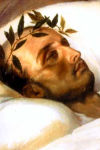However, the presence of the Emperor in Paris was an embarrassment, especially as the oppressed people and the army were supportive. On June 25th, 1815, he left the capital for Malmaison and on the 29th, after having offered to serve as a mere general, he was sent to Rochefort, where he arrived on July 3rd.
His plan was first to emigrate to the United States of America, but he soon surrendered to the English upon learning that Fouché, who had promised him a passport, was in fact planning to deliver him to the royalists. On July 15th, he embarked on HMS Bellerophon, commanded by Captain Frederick Maitland, who sailed to England.
In Plymouth, without beeing let set foot on English soil, Napoleon was notified the deportation decision taken by the British government. He vehemently complained of the baseness of the process. On August 7th, 1815, he was transferred to HMS Northumberland, departing for St. Helena, an island in the middle of the South Atlantic. He arrived there on October 16.
Napoleon stayed at first, until December 10th, at the Briars Pavilion, owned by William Balcombe, agent of East India Company, before moving, on December 10th, 1815, to Longwood.

The residence chosen for Napoleon by his English captors, under the pretext of security, was remotely related to what a dethroned sovereign, who had voluntarily surrendered to the generosity of his enemies, might expect. While there was a fortress on the island that would has made an acceptable residence, Napoleon was relegated to the inside of a building designed to be a summer residence, where humidity reigned supreme, located on an unhealthy and windswept plateau. Perhaps his guards regarded this as a lesson of humility to the one they further humiliated by recognizing only his rank as General.
At first under the authority of Admiral Sir George Cockburn, Napoleon soon received a new keeper in the person of General Hudson Lowe, who arrived in St. Helena on April 14th, 1816. The initial interview on the 17th left the Emperor with a favorable impression. But Lowe quickly showed a fussy, suspicious, and mean demeanor. His relationship with Napoleon rapidly degraded. All in all, the two men met only five times. After August 18th, 1816 and a violent outburst, they would not meet again.
As the exilee refused to accept the Russian and Austrian commissioners who stayed on the island, his company boiled down essentially to the few faithful individuals who comprised his immediate surroundings: the Count of Las Cases, the Grand Marshal of palace Bertrand and his wife, General Count of Montholon and his wife Albine, and General Baron Gourgaud. In addition, Louis Marchand, his valet, Jean-Baptiste Cipriani, his butler, Louis-Etienne Saint-Denis, a.k.a. Mamluk Ali, and Jean-Noël Santini, a sort of handyman.
This group, however, became reduced over time. Santini was the first to leave St. Helena on October 19th, 1816, when Sir Hudson Lowe required the departure of three servants; Las Cases was expelled on November 25 of that year for trying to communicate with France; on March 15th, 1818 it was the turn of Gourgaud to leave, his cohabitation with Montholon having become impossible; finally, on July 2nd, 1819, Albine de Montholon, the last mistress of Napoleon, abandoned both lover and husband to return to France.
For the deposed Emperor, a man capable of prodigious activity, the five-year stretch of his captivity passed nearly unnoticed, hearing the ridiculous arguments around him and plagued by boredom and homesickness. Idle, Napoleon reviewed his life, dictating his memoirs, honed his legend... and slowly decayed.
While his health had remained satisfactory until August 1817, then it started to degrade. In addition, physicians who treated him were far apart from each other: Dr. John Stokoe, surgeon of the English vessel The Conqueror, was accused of sympathy for the Emperor, brought back, and removed from the British navy officers; Barry Edward O'Meara, Irish doctor whose methods proved effective, was in turn expelled in September 1818 by Hudson Lowe. Thus, after the attack suffered by Napoleon on the night of January 16th, 1819, which left him prey to the penetrating pain in the right side, he founf himself without adequate care, refusing to consult the English doctors available. The family of the Emperor, and especially Cardinal Joseph Fesch, sent Dr. François Antommarchi, who arrived to St. Helena on September 19th, 1819. Unfortunately, Napoleon soon developed the worst opinion of him, leading the practitioner to consider leaving the island in January 1821. Moreover, Napoleon closed his door to him and would not open it again until his last days. Finally, British military surgeon Archibald Arnott gave the prisoner his last care.
In spring 1821, from April 13th to 29th, while the disease was close to completing his work, Napoleon carefully wrote a will and seven codicils, trying not to forget any of his supporters and establishing as executors Charles-Tristan de Montholon, Henri-Gatien Bertrand, and Louis Marchand, who he had just appointed Count.
Finally, the Emperor sent his ultimate recommendations to his son - whose communication had been non-existent throughout his detention - in case he would assume the throne of France. The text of his advice was dictated to Montholon on April 17th, 1821.
Napoleon died on May 5th, 1821 at 5:49 p.m.